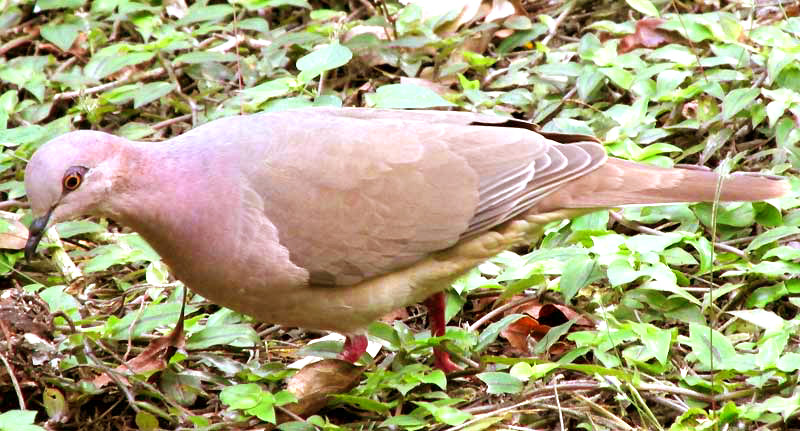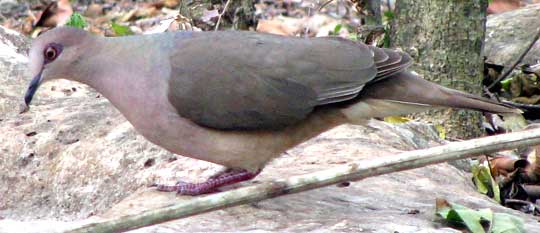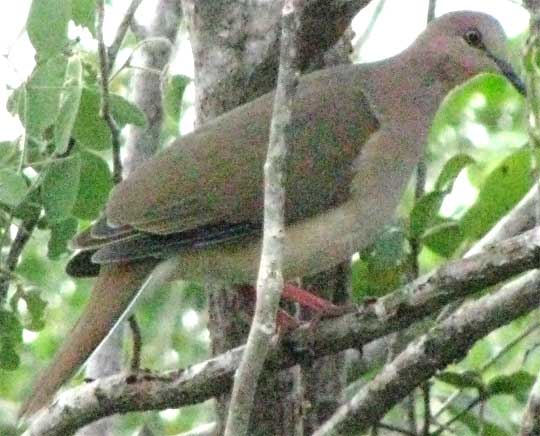Excerpts from Jim Conrad's
Naturalist Newsletter

from the January 24, 2016 Newsletter issued from Hacienda Chichen Resort beside Chichén Itzá Ruins, central Yucatán MÉXICO
WHITE-TIPPED DOVE
One of the pleasures of living in a traditional Maya thatched-roofed hut is that when I've been working at the computer and my eyes are tired, I can look outside between the wall's poles. Lately there's been more to look at because with the advent of the dry season and the days getting longer, the birds are developing spring fever. Now more birds are singing, they're more actively feeding and turning up where they can be seen. For example, one afternoon there was a rustling on the ground just beyond the pole wall where I was working, and above you can see what I saw between the poles.
from the March 21, 2010 Newsletter issued from Hacienda Chichen Resort beside Chichén Itzá Ruins, central Yucatán, MÉXICO; limestone bedrock, elevation ~39m (~128ft), ~N20.676°, ~W88.569°
AT THE HALTÚN WATERING HOLE
With the dry season bearing down hard now, every day I fill the haltunes, or natural watering holes in limestone rock, and all day long, every day, there's a continual parade of birds who arrive, land in branches above the haltunes, look around and look some more, then finally descend to drink their fill. Despite the heat often I throw an old, brown poncho over myself for camouflage and sit with my camera about 20 feet away, and wait.
The most frequent visitors at the Haltunes are Social Flycatchers, which we've photographed enough. Probably the second-most frequent are the White-tipped Doves, LEPTOTILA VERREAUXI. At most of my other Yucatán bases White-WINGED Doves were the most common dove species, sometimes the only. Here during the first four months I saw only White-tippeds, but recently White-wingeds have begun moving in. White-tipped Doves are distributed from southern Texas to Peru and Argentina. You can see one peering expectantly into a haltún below:

from the September 15, 2008 Newsletter written in Sabacché, Yucatán, MÉXICO
elevation ~10m ~33 ft, N20.659°, W89.370°
WHITE-TIPPED DOVES
Last week as I continued mapping trails I returned each day on a winding footpath through thorny forest about 20 feet high, and each day in the same spot I'd encounter one. At first he'd roly-poly amble away from me down the trail, then flutter loudly and heavily into the air, keeping low, and then vanish into heavy, shadowy undercover. About all I ever saw of him was that he was heavy and pigeonlike, bore no white wingbars like the White-winged Dove, but did have a white-tipped tail. In our area, that's all you need to see to know you have a White-TIPPED Dove, sometimes called White-fronted Dove, LEPTOTILA VERREAUXI. A few days later I got the picture of the one shown below:

The only other full-sized pigeon/dove in our area is the Red-billed Pigeon, which lacks the white-tipped tail. Farther east and south in rainier country with higher, more luxuriant vegetation, other species show up. For example, in forest near Cancún you can also look for Scaled Pigeons, White-crowned Pigeons, Caribbean Doves and Ruddy Quail-Doves. During the winter dry season North America's Mourning Doves also invade the whole peninsula. This is quite in contrast to the situation in North America where most of the continent is home to only two pigeon/dove-type birds: Mourning Doves and feral Pigeons.
One reason I give scientific names and often refer to an organism's genus is that genera and other groupings are defined by important features. In other words, if you're familiar with a genus's characteristics you automatically know a few things about each species in that genus. There's a good example of this when you read in Howell's A Guide to the Birds of Mexico and Northern Central America the description of the genus Leptotila, to which White-tipped Doves belong. Howell writes:
"These birds are common but retiring, terrestrial doves of forest and woodland. Most often seen singly or in pairs as they flush off through the understory; may be seen in the open at edges, on quiet roads, and trails."
This couldn't match my experience with them better.